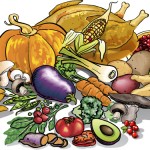This time a year we are bombarded with tips cooking, recipes and even food safety information related to cooking that big holiday dinner. That’s the purpose of this post, too. I know for some of this may be repetition or that I’m “preaching to the choir”, but food safety is not something to mess with. Also, a Thanksgiving dinner is a big undertaking. Some of these foods you only cook once a year, so you may not be as experienced with that food. Maybe you’re using a “older” recipe for a family favorite that contains ingredients are now considered potentially hazardous. Or simply there is just more food and more people than usual in your house. All of these can lead to potential food safety problems. Here are some of my last minute thoughts on Thanksgiving food safety.
- Get a head start on food safety. Wash the kitchen counter and sinks down with warm soapy water and a mild bleach solution before you get started. Do it again after you get the turkey in the oven, this will assure that you haven’t splashed raw turkey drippings onto surfaces that may later touch an uncooked food such as salad or desserts.
- Encourage all volunteer cooks and helpers to wash their hands before they start.
- Even though the refrigerator is stuffed full, don’t be tempted to store food in unconventional places—like the garage or porch. It may seem cold out there, but temperature is the key—it needs to stay below 40 degrees F. There is no guarantee that the temperature in your garage, porch or car trunk will stay cold enough to keep the food safe. The garage may warm up due to the heat from the car or the sun may come in through the porch windows and heat the air or the food. Not to mention critters and neighborhood pets that maybe attracted to your Thanksgiving meal. You might try an ice chest, but it will take some effort and a thermometer to assure that the food is being kept below 40 degrees
- Remember some of your guests may be more at risk than others. Great Aunt Bertine is in her nineties and the neighbor’s great grandchild is coming, too. The elderly and young children, organ transplant recipients and those with chronic illnesses may be more at risk of getting food borne illnesses than others. These folks are a good reason to take extra care—the last thing you’d want to do is to make one of them sick.
- Don’t allow food to sit at room temperature. I know it’s tempting to leave out for latecomers or a quick snack or sandwich later, but get those leftovers into the refrigerator as soon as possible. Even if the food is still a little warm, get it into the refrigerator to cool. The rule-of-thumb is two hours a room temperature for food safety—that’s cumulative over several days—so the sooner you get it into the refrigerator the less risk you’ll have over the weekend.
- If you still have large servings of food break them down into smaller containers to allow them to cool quickly. Cut the turkey off the bones and get the slices and pieces into the refrigerator quickly. I wrap and throw the bones into the freezer right away—it gets it out of the way and one less thing to worry about—to make soup some other day.
- All leftovers should be eaten or frozen by the end of the weekend. When heating leftover stuffing or gravy it’s important that is heated to at least 165 degrees.
The buzz phrase for food safety has always been “when in doubt—throw it out”.
I’m sure you probably don’t need this reminder… we are blessed with some of the safest food in the world for which I am thankful. Let’s work to keep it that way. Have a food safe day full of gratitude. Happy Thanksgiving.
Cheryle Jones Syracuse, MS
Professor Emeritus, The Ohio State University.
